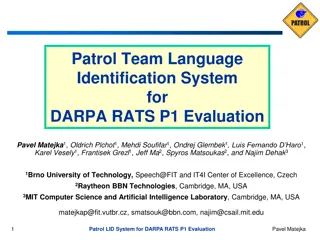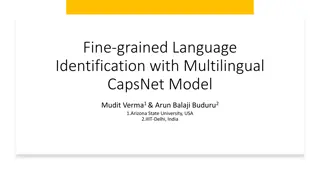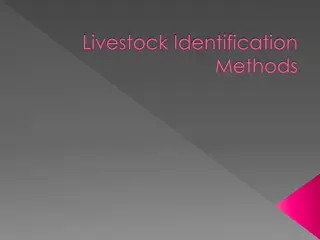A Concurrency Framework for Priority-Aware Intercomponent Requests in CAmkES on seL4
This research work proposes a concurrency framework designed to handle priority-based intercomponent requests efficiently in CAmkES on seL4. The framework supports reentrant execution, locked critical sections over shared state using IPCP, NPCS, and PIP protocols. It requires minimal changes to comp
0 views • 8 slides
Priority Activities and Action Plan for EW4All Infrastructure Commission: INFCOM-3 Session
The document outlines the priority activities and action plan for the Third Session of the Infrastructure Commission (INFCOM-3) within the Early Warnings for All initiative. It includes background decisions, a draft list of priority activities, and an action plan for contributions to the initiative.
5 views • 10 slides
Overview of Vibrio cholerae: Characteristics and Identification
Vibrio cholerae is a gram-negative, curved rod bacterium known for causing cholera. Its distinctive features include polar flagellum motility, oxidase-positive nature, and resistance to inhibitory substances. Various culture media are used for its isolation and growth, such as transport, routine, an
0 views • 8 slides
Decoding the GT Identification Process: Understanding the Numbers
Exploring the intricate world of Gifted and Talented (GT) identification, this insightful guide delves into the significance of 1s and 0s, the criteria for GT scoring, percentile ranks, and the importance of Ability Profiles. Discover the nuances of GT testing, identification, stanines, and more to
1 views • 19 slides
Understanding Talent Identification and Selection in Sports
Talent identification in sports involves recognizing and developing the total potential of athletes in various aspects, aiming for long-term growth rather than focusing solely on immediate performance. It focuses on understanding real potential and systematically developing it over time through qual
1 views • 9 slides
Rapid Identification System for Inmate Release
The Rapid Identification System, also called Rapid ID System, provides a quick way to verify an inmate's identity using fingerprints before release from custody. It allows law enforcement agencies, including IPD users under SDSheriff, to log in and access the system. By searching the San Diego AFIS
3 views • 8 slides
Proposal to Add National Security and Emergency Preparedness Priority Access Feature in IEEE 802.11be Amendment
The document proposes integrating the National Security and Emergency Preparedness (NSEP) priority access feature into the IEEE 802.11be standard to ensure seamless NSEP service experience, particularly in Wi-Fi networks used as last-mile access. The NSEP priority feature at the MAC layer is indepen
0 views • 12 slides
IEEE 802.11-20/0021-00 Priority Access Support for NS/EP Services Overview
This document discusses the importance of priority access support in IEEE 802.11be for National Security and Emergency Preparedness (NS/EP) services. It outlines the need for standardized mechanisms to ensure priority services in WLAN networks during NS/EP events when cellular coverage is unavailabl
1 views • 15 slides
Understanding LRIT System for Ship Identification and Tracking
LRIT (Long Range Identification and Tracking) system enables global identification and tracking of ships for security purposes. Ships equipped with LRIT system can autonomously transmit ship data to authorized authorities. LRIT system is mandatory for certain types of vessels as per SOLAS convention
0 views • 12 slides
Language Identification System for DARPA RATS Program Evaluation
The Patrol Team Language Identification System was developed for DARPA RATS Program to create algorithms and software for speech tasks in noisy environments. The system involved analyzing datasets, implementing subsystems for language identification, and evaluating performance across different langu
0 views • 19 slides
Understanding Priority Queues and Heaps in Java Collections
Explore the concepts of priority queues, heaps, and related data structures in Java Collections Framework. Learn about the Priority Queue class, Entry ADT, Comparator ADT, and Total Order Relations, along with their practical applications in process scheduling and more.
0 views • 44 slides
Understanding Heaps and Priority Queues in Data Structures
Exploring the concepts of heaps, priority queues, and the Priority Queue ADT in the context of data structures. Topics include the implementation of priority queues, comparing different data structures for efficiency, and the behavior of operations like insert and removeMin.
0 views • 40 slides
Understanding Priority Queues and Heaps in Java
Explore the concepts of priority queues, heaps, and their implementations in Java. Learn about efficiency tradeoffs, interface vs. implementation, and the primary operations of priority queues. Discover the importance of comparable elements and the various data structures used for efficient operatio
0 views • 49 slides
Understanding Priority Queues and Heaps in Data Structures
Priority queues prioritize item retrieval based on value, contrasting with traditional queues that follow a first-in-first-out approach. Priority queues efficiently manage items based on their importance, often utilized in scenarios like emergency rooms or air traffic control. Heaps, a form of binar
0 views • 20 slides
Understanding Priority Queues and Heaps
Priority queues differ from regular queues by maintaining an ordering of items based on priority rather than first-in-first-out. Items in a priority queue are assigned priority values and the highest priority item is removed first. Different data structures can be used to efficiently insert and remo
0 views • 54 slides
Understanding Priority Queues and Heaps in Data Structures
Priority Queues are data structures that support operations like Enqueue, Dequeue, Insert, and deleteMin, where elements are ordered based on priority. This article covers various aspects of Priority Queues, including their implementation, applications in operating systems, and the concept of Binary
0 views • 25 slides
Understanding Binary Heaps: Efficient Data Structure for Priority Queue Operations
Explore the concept of binary heaps, a specialized type of binary tree that allows for quick retrieval of the smallest (or largest) element. Learn how binary heaps excel in finding the minimum value, essential for priority queue applications in operating systems, event simulations, and more. Compare
2 views • 34 slides
Implementing a Priority Queue with Heaps
Learn about implementing a priority queue using heaps. Priority queues are essential data structures that maintain a special ordering property. The use of binary trees and heaps is explained in detail, focusing on maintaining shape and heap properties during insertions.
0 views • 57 slides
Understanding Priority Queues and Heap Data Structures
Priority queues play a key role in computer science algorithms by managing data based on priority levels. The use of heap data structures enhances the efficiency of priority queue operations. This tutorial covers the basics of priority queues, their applications, different implementations such as li
0 views • 30 slides
Priority Queues in Java: Implementation and Use Cases
Explore the concept of priority queues in Java, covering implementations using unsorted and sorted linked lists, as well as heaps. Learn about the differences between a queue and a priority queue through reading quizzes and discover various priority queue implementation options. Dive into priority q
1 views • 42 slides
Priority Queues: Operations and Implementations
Priority queues are data structures that allow efficient insertion, deletion, and retrieval of elements based on their priority. This information-rich content covers various aspects of priority queues, including ideal times, binomial queues, Dijkstra's algorithm for single-source shortest paths, and
0 views • 11 slides
Understanding Priority Queues and Heaps in CS2110
Delve into the realm of priority queues and heaps in the context of CS2110 during the Fall of 2015. Explore the differences between heaps and Binary Search Trees (BSTs) through desirable properties and advantages each structure offers. Discover how stacks and queues are implemented as restricted lis
1 views • 50 slides
Understanding Priority Queues and Heaps in Data Structures
Exploring the concepts of priority queues, heaps, and various data structures like linked lists, binary search trees, and interfaces like Bag. The content covers comparisons between BSTs and heaps, efficiency purposes in data structures, and implementations of stacks and queues. Learn about the sign
0 views • 50 slides
Understanding Priority Queues and Heaps in CSE 373 Lecture
Today's lecture in CSE 373 covers the Priority Queue Abstract Data Type (ADT), the properties of heaps, and their implementations. Key topics include the completeness property of heaps, different priority queue implementations such as the binary search tree for faster insert and find operations, and
0 views • 21 slides
Mineral Identification Challenge for 7th Grade Science Students
Engage in a Mineral Identification Challenge where 7th-grade students will explore various minerals using color, streak, luster, transparency, texture, composition, density, crystal shape, cleavage/fracture, hardness, and special properties. Students will rotate through different stations, perform t
0 views • 11 slides
Livestock Data Management and Recording Guidelines
This documentation outlines the correct procedures for submitting livestock data, including details on birth notifications, calving information, AI processes, calf identification, and more. Topics covered include birth dates, twin identification, AI horn codes, dam and sire identification, calving e
0 views • 11 slides
Priority Setting in Healthcare in Chile: Social Value Judgements and Health Programmes
The presentation discusses the context of priority setting in healthcare in Chile, focusing on social value judgements and the principles of national health programmes with universal coverage. It highlights key statistics about Chile's healthcare system, including population, GDP per capita, and hea
0 views • 20 slides
Understanding Priority Matrix in Teams
Priority Matrix is a valuable tool in the A/C/E industry, allowing teams to prioritize tasks efficiently, communicate priorities effectively, and track progress accurately. Real teams benefit from its use cases in prioritization, communication, and progress tracking, creating a roadmap for workflow
0 views • 23 slides
DHHS Coordination of Transportation Service Contracts Overview
The Department of Health and Human Services in Maine conducted an assessment of Transportation Services in June 2019. The workgroup identified three main priorities: alignment of Quality and Performance Measures, Safety Measures, and Evaluation of Transportation Services. The first priority involves
0 views • 28 slides
Stakeholder Perspectives on Research Priority Setting for Public Health in LMICs
Stakeholders in a special session at the 22nd Cochrane Colloquium 2014 discussed the importance of involving diverse stakeholders in research priority setting for public health issues in Low- and Middle-Income Countries (LMICs). Key topics included barriers to patient involvement, challenges in addr
0 views • 13 slides
Proposals for Prioritizing Bids and Managing Collateral Requirements in Auctions
Market Participants face significant collateral requirements in auctions due to multiple bidding zone borders. Proposal to assign priority to bids for credit limit reasons aims to address randomness in bid rejection. Bid XSD is extended to include priority as a component, enhancing bid management ef
0 views • 6 slides
Fine-Grained Language Identification Using Multilingual CapsNet Model
This study explores fine-grained language identification through a multilingual CapsNet model, addressing challenges such as short audio snippets, multiple languages, noise, limited training data, and non-class identification. The dataset includes various languages like Arabic, Bengali, Chinese, Eng
0 views • 36 slides
Livestock Identification Methods: Exploring Different Techniques
Explore the importance of livestock identification, methods used, and their significance in various situations. Understand why animals need to be identified, from proof of ownership to disease eradication. Learn about types of identification like branding, ear notching, tattooing, and more, each wit
0 views • 16 slides
Understanding Remote Identification of Unmanned Aircraft: Compliance Methods
The Final Rule on Remote Identification of Unmanned Aircraft introduces compliance methods for the model aircraft community to fly safely in national airspace. Explore the three ways to comply, including Standard Remote ID, Broadcast Modules, and FAA Recognized Identification Areas. Learn about regi
0 views • 11 slides
Understanding Structural Identification in Vector Autoregressions
Explore the algebra of identification problems in VARs, including Cholesky factorization, timing restrictions, long-run impact restrictions, sign restrictions, and identification through heteroskedasticity. Discover why structural identification is crucial for policy design, economic modeling, and u
0 views • 63 slides
Overview of Fall Semester 2019 HPC Current Report
The Fall Semester 2019 HPC Current Report highlights changes made in resource allocation, job queue management, utilization analysis, and factors influencing job priority. Key modifications include adjusting memory per CPU, implementing limit enforcement, and changing fairshare weights. The report d
0 views • 20 slides
Understanding Minerals: Properties and Identification
Minerals are naturally occurring solid inorganic substances with definite compositions and structures. They are classified based on physical and chemical properties. This content discusses the definition of minerals, the conditions that classify gold as a mineral, distinguishing mineral characterist
0 views • 29 slides
Performance Studies of dRICH Detector at ePIC Experiment
The Electron-Ion Collider ePIC experiment focuses on the performance studies of the dRICH detector for particle identification crucial in various physics channels. The detector features aerogel optimization, SiPM sensors, and test-beam analyses. Key capabilities include different techniques for part
0 views • 28 slides
Fundamentals of Marketing: Product Identification and Branding Insights
Explore the essential concepts of marketing including the marketing mix, product identification methodology, and the significance of branding in differentiating products. Learn about the 4Ps of marketing mix - Product, Price, Place, and Promotion, and how branding plays a crucial role in establishin
0 views • 15 slides
Suicide Prevention Advisory Group Monthly Meeting Summary
The Suicide Prevention Advisory Group held their monthly meeting discussing collaboration with SMEs, funding priorities, consensus panel timeframe, portfolio reorganization in ISRM, AMP development, survey data review, and priority setting process. They also reviewed initial results from the SP Prio
0 views • 39 slides






































